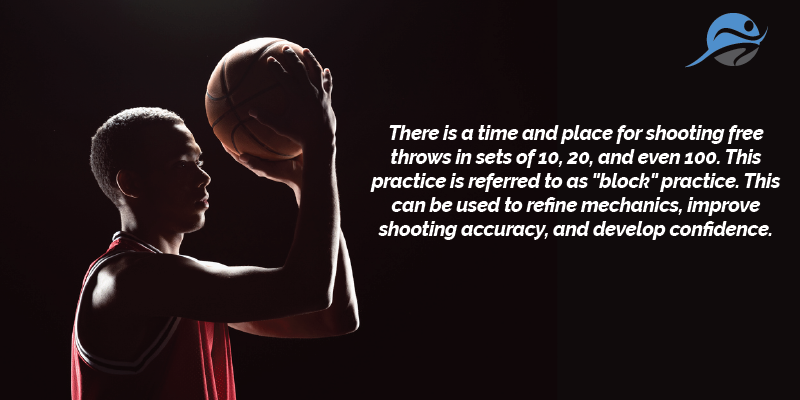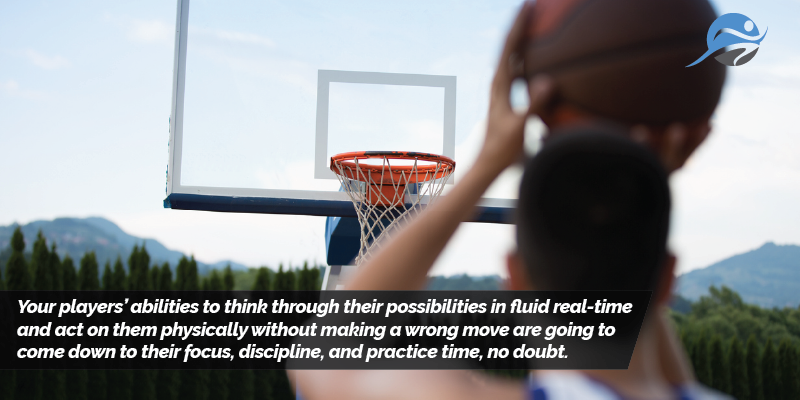Practicing Free Throws: Teaching Focus

Many winners and losers in sports are determined by small moments during the course of a game. The outcomes of those small moments are largely determined by little decisions from moment to moment, small movements and technical flourishes either thought out or not that alter the course of the game. Successful players are those who become so in-tune with their technical vocabulary and bodily capabilities that they’re able to focus and make multiple good small decisions in a row at any given time and make things happen. It all starts with the practice regimen and how your players think about their improvement.
Focus and Free Throws

Have you ever had those players that seem to knock down 85% to 95% of their free throws during practice but when it comes game time, their free throw shooting percentage almost drops in half? That can be one of the most frustrating things for both the coach and the player. You know that you can knock down the free throw, but for some reason something is happening during the games and you keep shooting a lower percentage. Honestly, nobody seems to have the answers to everybody's free throw shooting woes, as there are just far too many factors. While it is nearly impossible to truly simulate game situations during practice, there are some things that you can do to make free throw shooting more game-like and lead to better free throw shooting during games.
There is a time and place for shooting free throws in sets of 10, 20, and even 100. This practice is referred to as "block" practice. This can be used to refine mechanics, improve shooting accuracy, and develop confidence. This is crucial for beginners, as block practicing is fundamental to teaching focus, discipline, and self-control to players, especially young ones. It’s what instills the idea of hustling for the gold, even if that gold is far out. It’s in the same vein as working out or rehearsing -- instant gratification is set aside in favor of real improvements over the long-term.
Block practicing also creates a routine and muscle memory throughout the player’s mind and body, allowing them to work through the motions required of what they’re practicing more smoothly and fluently. This can introduce them to flow state and other forms of deep focus where their mental energy and attention can be placed on minutia and quickfire decisions. This discipline and understanding of focus as both passive and active can help gel the connection between deep focus and mechanics.
Head in the Game

There is a certain point, however, where you need to up the ante and make things more difficult by adding pressure and making practice more game-like. Drilling games and exercises are an easy way to push your players to want to put in repetitions. Plus / Minus Shooting is a great example of a free throw game that can add that pressure element. Here is how it works:
Keep score via taking free throw shots
+1 on misses.
-1 on makes.
Start at 5.
Reach 0, you win.
Reach 10, you lose.
So on every make, you decrease your score by 1. On every miss, you add 1 to your score.
Your score starts at 5. If you want to add more difficulty, you can increase the penalty on misses to +2, +3, or even +4. You can also increase the starting number to 6, 7, 8, or 9 and adjust from there to find a good flow that works well for you or your player. This game encourages repetition of mechanics, as every player will eventually get stuck in a position where they have to get it right to finish the game. As the game’s parameters become more and more customized to what works for the player, so will their own personal mechanics and technique, and they’ll find their own way to connect their mental focus with their body’s response.
Another example of a workout game that can help to build skill in repetitions and focus is The 2 Free Throw Workout. This workout involves working on a skill, then shooting two free throws. You continuously alternate between the skill work and two free throws, and the skill work could include some ball handling, defense, post moves, perimeter shooting, and any other skill work. Over time, this can involve quicker, more intense sets of skill work in order to attain a high amount of free throws. It’s apparent that some free throw shooters will often get on a roll when they shoot a high amount of free throws in a row, but how often do we see someone shoot 20 free throws in a row during a game? Typically, it's 1, 2, or 3 in a row, so it makes sense to incorporate practicing them into your workouts and exercises that way.
Here are a couple of examples for segments during the workout:
Corner to Wing Cut - 3 Shots - Shot, 1 dribble lay up, 1 dribble jump shot
2 Free Throws
Corner to Wing Cut - 3 Shots - Shot, 1 dribble lay up, 1 dribble jump shot
2 Free Throws
Corner to Wing Cut - 3 Shots - Shot, 1 dribble lay up, 1 dribble jump shot
2 Free Throws
Corner to Wing Cut - 3 Shots - Shot, 1 dribble lay up, 1 dribble jump shot
2 Free Throws
Two Ball Dribbling Through Chairs - Pound Dribble - Low, Mid, High
2 Free Throws
Two Ball Dribbling Through Chairs - Alternating - Low, Mid, High
2 Free Throws
Two Ball Dribbling Through Chairs - Hi-Lo, Change, Two Changes
2 Free Throws

As you can see from the examples, you simply take a drill and chop it up into segments to shoot free throws in between the different variations of the drill. There are many ways that you could put this together for your team or players down to a unique scale. Make sure to chart your players’ shooting so you can track their percentages and document their improvement. The tangible measure of the effects of drilling will act not only as a motivator for your players, but as a controlled indicator for you on what best to work on together.
Focus is one of the few elements that can make or break any athlete. Your players’ abilities to think through their possibilities in fluid real-time and act on them physically without making a wrong move are going to come down to their focus, discipline, and practice time, no doubt. Practicing and drilling technique like this is the only surefire way to avoid those wrong moves, as correcting those is just as important as improving the right ones.